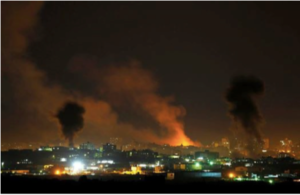Regime Change Az Theatre 2
Having focused for some years on projects with an international dimension, I decided earlier this year (2016) to turn my attention to what was happening in the UK. A lot of talk during the Iraq invasion and the 2011 popular uprisings in Tunisia, Egypt and elsewhere was about the idea of ‘regime change’. I set out to see what this might mean here. What was the story of the UK regime? My research took me back to what I considered to be its founding moments in the revolutionary movements of the English Civil War (1641-1660) whose final act might be considered to be the constitutional settlement of 1688. I was setting out to create theatre but I knew it might take a long time. I have started writing drama but also I am accompanying this work with a blog that would outline my thinking as the project moved forward.
Specifics of the British Regime
A regime is a set of organisational processes that come together at a particular place at a particular time. We can imagine that they are like components or practices or institutions or even images. Some combining factor arises on the basis of local human settlement that holds together a particular version of human society. What holds a social formation in place is not separate from the elements that, in one way or another, give it a constitution. It is difficult to come to terms with the nature of this entity which in our imagination can appear to be like a body, a culture, a machine or a system. In social theory it can be called ‘an imaginary’ (1) or an ‘assemblage’ (2) though I don’t want to ignore the distinctions between these different theoretical notions.
The roots of a regime appear to be in geography or ecology: these people living on this particular part of the earth at a particular point in time, a variation on, and in interaction with, the human species.
So what account can be given of the one that has arisen on the British Isles. We cannot be as definite about the time-scale as we can about the location.
The British Isles are relatively easy to identify on a map though the borders between the different nations may not be obvious. England describes the area of the main island that was subject to the Roman invasion of 2000 years ago. All other major migrations or invasions have been determined by its frontiers. The domination by London of England, and by England of the British Isles, is due to the extraordinary harbourage offered by the Thames estuary. This is a significant determinant of the regime
As for time-scale, the present determines the way we look at the past. So, for example, if we were facing the extinction of human life on these islands we would tend to start our story with the arrival of human beings here after the last ice age some 11,700 years ago. However, at the moment, there are more human beings living here than there have ever been.
What is happening now and to what initial processes is our attention drawn?
In general terms, we are witnessing tensions in relations between the nations that make up the British State, between the role of financial services and manufacturing and between the London and the ‘provinces’. There are uncertainties about the two party system and the role of political parties, also about the nature of the House of Lords. The military function of the British State has been radically called into question by the inquiries into the ‘war’ on Iraq. This last may be inextricably tied to British dependence on the United States and this offers another underlying tension.
The institutional components that were drawn together in the period after the English Revolution of 1641-1660, particularly in the period leading up to the settlement of 1688, appear to be those that are in crisis now.
The success of London as a capital was focused on finance and banking. There were the networking benefits and the medium term assurances of a centralised intermarrying ruling elite, enhancing trust and contractual security, that connected landed wealth with mercantile enterprise. This nexus was centred in London. The relationship of government to the imperialist commercially-driven military expansion, crucially organised through the formation of the Bank of England (1694), sealed the advantages of a communications structure that focused on the royal court but wasn’t dominated by it.
Within 20 years of the foundation of the bank the new regime had fought a successful war against the French in North America and Europe, climaxing with the Treaty of Utrecht (1714), had unified Scotland with England and Wales (1707) and had secured the Hanoverian protestant succession and began to construct ‘British’ identity.
Anglican Protestantism offered the basis for a unique national ‘loyalty’ test as well as an ethos suited to capitalism. The unique combination of a monarchic head of state who was both the military commander-in-chief as well as head of the Church of England fastened and refined the regime-building project. The ideological underpinning of a state religion sustained the new regime through the first founding period until, for example, in the earliest years if the 19th century, the need to avow the protestant religion as well as allegiance to the monarch for members of the volunteer militia was dispensed with
The fertile ground made up of financial fluency, protestantism and co-ordinated military and commercial enterprise bred a functioning and compelling model of the human in the figure of the English gentleman and this gave personality and moral coherence to the regime.
War as a profitable venture and as a ‘keynote’ national unifier has played a unique role throughout, from Blenhiem (1704), to Waterloo (1815), to the Somme (1915), to Dunkirk (1940), to D-day (1944), to the Falklands (1982) and to Iraq (2003). Apart from the massive destruction of the Blitz the wars have always been fought elsewhere. This doesn’t diminish the loss of life and the concentration of production effort.
The country was never invaded and therefore never faced the decisive crises that invasion brings. Victory was something that was brought home and delivered rather than fought for at home. This distinguishes the history of the British Isles since 1066 from most other locations.
The development of the British regime has at its core the development of the British state. State-making and war-making are synchronous. (3) The effect on the administration and style of government of the ‘seniority’ of the British Navy, rather than the continental ‘army’-based regimes is considerable. The sustained coherence of the British ‘officer’ class in delivering ‘successful’ military adventures abroad has, up until recently, been formative for the regime.
I am only intending here to give some broad and general markers or headings of where my research has taken me. The books that have been central are Britons by Linda Colley (4) and The Enchanted Glass by Tom Nairn (5).
Notes:
(1) This term was developed by Greek French philosopher Castoriades see The Imaginary Institution of Society [IIS] (trans. Kathleen Blamey). MIT Press, Cambridge 1997 [1987]. 432 pp. ISBN 0-262-53155-0. (pb.)
(2) This term was developed in Deleuze and Gattari’s A Thousand Plateaux see Deleuze, Gilles; Guattari, Félix (1993). A Thousand Plateaus. Minneapolis: University of Minnesota Press. pp. 14, 26–38, 135–139, 149–166, 195, 198, 235–236, 240, 241, 259, 390, 534, 539, 559. ISBN 0-8166-1402-4.
(3) See the work of Charles Tilly
(4) Colley, Linda Britons, Forging the Nation 1707-1837 Yale University Press 1992
(5) Nairn, Tom The Enchanted Glass, Britain and its monarchy Century Hutchinson 1988



